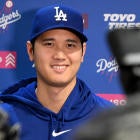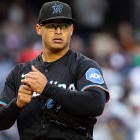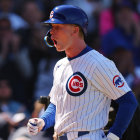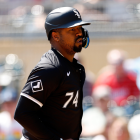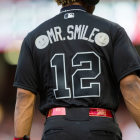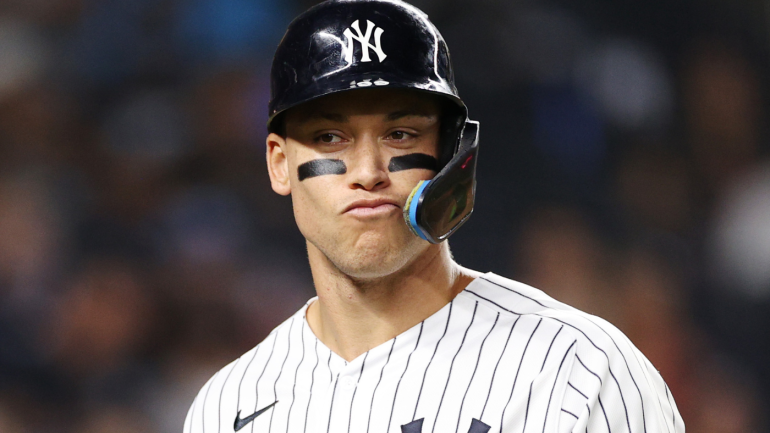
At some point in the next four months, reigning AL MVP Aaron Judge will sign a contract worth hundreds of millions of dollars. I don't know when it will happen -- it could happen as soon as the Winter Meetings next week or as late as spring training (like Bryce Harper four years ago) -- but it'll happen. I assure you Judge will not be unemployed when Opening Day arrives March 30.
In spring training Judge rejected a seven-year extension worth $213.5 million that was very reasonable at the time but not so much now, after he hit an American League record 62 home runs and fell only five batting average points shy of a Triple Crown in 2022. The New York Yankees are, of course, trying to retain their franchise player; owner Hal Steinbrenner recently met face-to-face with Judge to convey how much he wants him to stay, and also to explain the team's plans moving forward.
"I just want him to know how I felt. In case there was any lack of clarity or ambiguity," Steinbrenner told NJ.com in November. "We have plenty of ability to -- and Aaron and I talked about this -- to make this happen and still have money to make other things happen ... My budget for Judge is going to be what I feel we can do. It's not limitless, obviously. But am I going to make moves before we're able to -- in my opinion, we're going to be able to sign Aaron. That's not going to stop me from signing other people."
The Yankees have already re-signed Anthony Rizzo, one of Judge's closest confidants on the team, though signing a player's best buddies doesn't automatically mean you'll land the player (remember when the White Sox signed Yonder Alonso in a failed attempt to woo his brother-in-law, Manny Machado?). The San Francisco Giants, Judge's hometown-ish team, have money to spend and are making a strong push to sign him. Giants ownership reportedly craves a star and they brought Judge in for a meet-and-greet last week. They got Golden State Warriors star Steph Curry involved and Joc Pederson is doing his part too:
Joc Pederson doing his part in recruiting Aaron Judge to the Giants 👀
— 95.7 The Game (@957thegame) November 23, 2022
(via @yungjoc650 / IG) pic.twitter.com/44FB3rwBym
As far as we know the Yankees and Giants are the two main suitors for Judge, though I wouldn't rule out the Los Angeles Dodgers and other teams (Chicago Cubs? New York Mets?) getting involved before it's all said and done. My hunch -- and I emphasize this is just a hunch -- is Judge returns to the Yankees, though I admit I am less certain about that now than I was a few weeks ago.
There is a chance Judge leaves the Yankees to sign with Giants or Dodgers or whoever. I don't know what those chances are, but they're definitely not zero. And if Judge does leave, it would be a devastating blow to a Yankees team trying to get back to the World Series for the first time since 2009. The way I see it, the Yankees have four options in the event Judge leaves. Let's break down their potential Plan Bs.
Option 1: Sign a different star
The plan: The Yankees take the money they were going to give Judge and give it to another big name instead. Carlos Correa and Trea Turner are the only other free agents worth that kind of contract this winter, so one of them. The Yankees sign a different star and then proceed with the rest of their offseason however they were planning to proceed with it after re-signing Judge.
Example: Sign Correa or Turner. There you go.
The upside: You still have a bona fide star to anchor the lineup and sell the tickets, though neither Correa nor Turner will draw a gate the way Judge does. The marquee value of a homegrown superstar is almost impossible to match. On the field, the Yankees walk away from the offseason with one of the best players in the world and an elite performer, just not Judge.
The downside: Signing Correa or Turner does not address the outfield. The Yankees need a right fielder and would prefer it to be Judge, and they also need a left fielder after Andrew Benintendi became a free agent. New York has in-house shortstop candidates in top prospects Oswald Peraza and Anthony Volpe (and Isiah Kiner-Falefa, who is still on the roster), so I guess the solution would be signing Correa or Turner, then trading Peraza and/or Volpe for outfield help (Bryan Reynolds?).
Signing a top free agent shortstop and then trading the kids for outfield help is a viable plan. It also adds more steps to the offseason, and when you add more steps, you add more potential for missteps. Also, the Yankees know Judge can handle and thrive in New York. I generally think the "he can't handle New York" thing is overplayed, but until you see someone in that environment, you never know. Give Judge's money to another star and you're rolling the dice in a way you aren't by just re-signing Judge.
Option 2: Spread the money around
The plan: Instead of signing one big star to replace Judge, the Yankees could use the money to sign several second tier free agents to smaller contracts. Two Bs instead of one A, or one B and two Cs instead of one A. That kind of thing.
Example: Re-sign Benintendi and sign Brandon Nimmo to fill the two corner outfield spots, and also add to the rotation with, say, Carlos Rodón. How's that sound?
The upside: The Yankees would raise the floor of their roster by upgrading multiple positions. Yes, the downgrade from Judge to Nimmo in right field would be significant, though the upgrades in left field (a full season of Benintendi) and in the rotation (Rodón instead of Domingo Germán) would more than make up for it. The Boston Red Sox won a World Series this way in 2013, signing several veterans to short-term deals and closing all the holes on their roster.
It should be noted the Yankees tried this somewhat during the 2013-14 offseason. After Robinson Canó left to join the Seattle Mariners, the Yankees pivoted to sign Carlos Beltrán, Jacoby Ellsbury, Brian McCann, and Masahiro Tanaka. From covering the Yankees at the time, my sense was they planned to sign McCann (they badly needed a catcher) and Tanaka (he was a 25-year-old potential ace) no matter what, and they essentially replaced Canó with Beltrán and Ellsbury. They could try that again with Judge.
The downside: The money never works as neatly as you think (or hope) it will. For argument's sake, let's use the FanGraphs contract projections for each player:
| Years | Total dollars | Per year | |
|---|---|---|---|
OF Aaron Judge | 8 | $300 million | $37.5 million |
| Years | Total dollars | Per year | |
OF Andrew Benintendi | 4 | $56 million | $14 million |
OF Brandon Nimmo | 5 | $100 million | $20 million |
LHP Carlos Rodón | 5 | $135 million | $27 million |
Total | -- | $291 million | $61 million |
The total dollars are essentially a wash. They've signed three players -- three very good players -- for roughly what it would take to retain Judge. We could even go further and say that instead of signing Rodón, the Yankees could sign Justin Verlander (2 years and $70 million) and Willson Contreras (4 years and $70 million). That works out to $296 million for Benintendi, Contreras, Nimmo, and Verlander. Wouldn't you rather have those four than one Judge?
Total dollars are only part of the equation though. How that money is distributed matters, and our hypothetical Benintendi-Nimmo-Rodón package would run $61 million per season. The Benintendi-Contreras-Nimmo-Verlander package would be even pricier at $86.5 million per season. Yeah, the total dollars work out, but it's much a larger annual commitment, and annual salary matters to a Yankees team that is a little too obsessed with the competitive balance tax these days.
Assuming the Yankees have $40 million per year earmarked for Judge, it would presumably be enough to land Benintendi and Nimmo, but not a third high-end player (like Rodón). Two 3 WAR players is not the same thing as one 6 WAR player. Roster spots are finite and the one 6 WAR player leaves you with an extra roster spot you can fill with anything, including another 6 WAR player. All things being equal, you'd rather have the star player. They're hardest to acquire and most impactful.
The "spread the money around" plan is never as juicy as it seems. The likely outcome is not a package laden with big names like Benintendi, Nimmo, and Rodón. Odds are it would be something along the lines of Nimmo, Mitch Haniger, Michael Wacha, and maybe a reliever. Nothing wrong with those guys! Haniger and Wacha are quality major leaguers. It's just that when they're the alternative to a player like Judge, you're gonna have a hard time convincing fans it was smart not to pony up what it took to re-sign the homegrown star.
By the way, the Yankees won 85 games with Canó in 2013, then pivoted to Beltrán, Ellsbury, McCann, and Tanaka that offseason only to win 84 games in 2014. Spreading the money around may raise the team's floor, but eschewing stars also lowers the team's ceiling.
Option 3: Go young
The plan: Judge is one of the very best players in the world and that was true even before his 62-homer season. He was the AL MVP runner-up as a rookie in 2017 and he finished fourth in the voting in 2021. Judge is close to irreplaceable. Why bother trying to replace him? If he leaves, the Yankees could shift toward youth and try to develop their next homegrown core. Keep in mind New York had the oldest collection of position players in baseball in 2022. With or without Judge, a youth infusion is required.
Example: Peraza or Volpe at shortstop, perpetual prospect Estevan Florial manning one outfield corner and late season call-up Oswaldo Cabrera in the other, and 2017 first-round pick Clarke Schmidt gets a rotation spot no questions asked after spending the last three years yo-yoing between Triple-A, the rotation, and the bullpen. The Yankees could even do something like trade Gleyber Torres, whose name has popped up in trade rumors since the deadline, to open up second base for whichever one of Peraza and Volpe isn't at shortstop. Point is, the Yankees could go young in the wake of Judge's departure.
The upside: There's gold in them thar prospect hills. Give talented young players a chance and they'll surprise you. The Yankees know this as well as anyone. 2017 was as close to a rebuilding year as it gets for this franchise (Yankees brass called it a "transition" year that spring). Judge was going to play right field, Gary Sánchez was going to catch, and Luis Severino was going to stay in the rotation. All three were given the opportunity to sink or swim in their first full MLB season, and all three went to the All-Star Game that year and helped the Yankees to Game 7 of the ALCS.
The upside is obvious. A full-fledged youth movement could result in a new Yankees core emerging just as the previous core departs/ages out, setting the Yankees up for long-term contention. And going young does not automatically mean punting on contention. There are 12 postseason spots now and both pennant-winners had rookie shortstops in 2022. You can go young and still contend in this league. The Cleveland Guardians won the AL Central with the youngest roster in baseball!
Losing Judge to free agency could push the Yankees toward a youth movement and, as the Yankees learned in 2017, that youth movement could be a pleasant surprise and provide immediate results. An added bonus for ownership would be staying under the $233 million competitive balance tax threshold. FanGraphs estimates New York's 2023 CBT payroll at $222.2 million. Staying under the $233 million threshold would reset the team's tax rates and puts them in a more favorable position next offseason with regards to qualified free agents. In other words, it would set them up very well to pursue Shohei Ohtani (👀).
The downside: Well, prospects are known to disappoint, and it's always possible a wide scale youth movement blows up in the Yankees' face. The downside is they miss the postseason (even the expanded 12-team field) and the young players see their stock take a hit, both internally (the Yankees no longer see them as part of the future) and externally (their trade value is severely compromised). In that case the Yankees would have no Judge, no emerging core, and they will have seen another year of Gerrit Cole's prime tick away. It would be the worst case scenario, really. A youth movement comes with a ton of upside and gosh, when it works, nothing is more fun in this sport. The downside is real though. Going young comes with a lot of risk.
Option 4: A combination of Options 1-3
The plan: The Yankees don't necessarily have to pick a lane and stick to it. Should Judge leave, they could use the money they had earmarked for him to sign a star, then spend a little extra on a second tier free agent, and also go young at select positions. It's a mix of Options 1-3.
Example: How about signing Correa to play short, signing Benintendi or Haniger to man one corner outfield spot, then going young at the other corner outfield spot (Cabrera) as well as at another infield position (Peraza with Torres traded)?
The upside: This approach leaves every door open and allows the Yankees to be opportunistic. They don't have to spend big on a star, but if the market squeezes a big name the way Correa got squeezed into what amounted to a one-year deal last offseason, they can jump on it. They don't have to sign two or three second tier free agents to plug holes, but if there are sensible deals to be had in January and February, they can pounce. They also don't have to throw the kids right into the fire in 2023, though the ability to do so will still be there. This allows for maximum flexibility.
The downside: The downside is you wind up with a mishmash roster without a clearly defined plan. Are you going for it by signing a big star? Are you trying to hold down the fort until the next core arrives by signing second tier free agents? Or are you committing to a youth movement and going with the kids? Option 4 calls for doing all of those things but also not specifically one of those things. Going young could hamper the efforts to win now. Signing a big free agent (or other lesser free agents) could stand in the way of a youth movement. The Yankees don't have to pick a lane, but it helps to know which way everyone should be going.
The Yankees have reportedly reached out to all the notable non-Judge free agents in recent weeks and my sense is they're doing their due diligence more than sincerely pursuing alternatives to Judge. I'm sure the Yankees have a Plan B in mind -- Steinbrenner and GM Brian Cashman wouldn't be doing their jobs if they hadn't at least considered backups -- but their priority is Plan A. They want to re-sign Judge and don't seem as willing to let him leave as they were Canó. But until Judge signs on the dotted line, the possibility he leaves exists, and Judge leaving would send the Yankees into scramble mode.























